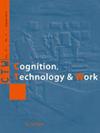服装工人的工作场所康复:一个多案例研究。
IF 3.4
3区 工程技术
Q2 ENGINEERING, INDUSTRIAL
引用次数: 0
摘要
服装工人由于其工作的高度重复性,有患与工作有关的上肢疾病(WRULD)的风险。基于工作场所的康复(WBR)通过在工人的工作场所提供干预,促进工作绩效的改善。目的探讨服装工人上肢疾患的职业治疗康复效果。方法采用多病例研究设计,采用回顾性资料回顾法。所有在南非开普敦的学生职业治疗实践中接受治疗并进行干预前和干预后结果评估的上肢疾病服装工人都被纳入研究(n = 7)。数据来自职业治疗和医疗档案。结果70% (n = 5)的患者经WBR后病情好转,30%的患者无好转或恶化。参与者在4至6周的时间内接受3- 5次个人WBR会话,每次约30分钟。干预措施包括工作站适应、工作轮换、心理教育、工作任务修改、辅助技术和锻炼计划。结果测量最常用的是RULA、DASH、波士顿腕管问卷和使用VAS的疼痛强度。结论基于工作场所的职业治疗可有效改善服装工人上肢功能、疼痛和人体工程学风险。本文章由计算机程序翻译,如有差异,请以英文原文为准。
Workplace-based rehabilitation with garment workers: A multiple case study.
BACKGROUND
Garment workers are at risk of developing work-related upper limb disorders (WRULD) due to the highly repetitive nature of their work. Workplace-based rehabilitation (WBR) facilitates improvement in work performance by providing intervention at the worker's place of work.
OBJECTIVE
This study aims to determine the documented outcomes of workplace-based occupational therapy rehabilitation of garment workers with upper limb conditions.
METHODS
A multiple case study design was used through a retrospective record review. All garment workers with upper limb conditions who were treated at a student occupational therapy practice in Cape Town, South Africa, with pre- and post-intervention outcome assessment, were included in the study (n = 7). Data were extracted from occupational therapy and medical files.
RESULTS
70% of the cases (n = 5) improved after WBR while 30% of cases showed no improvement or deterioration. Participants received 3- 5 individual WBR sessions of approximately 30 minutes each, over a period of 4 to 6 weeks. Interventions included workstation adaptations, job rotation, psychoeducation, work task modification, assistive technology and exercise programmes. Outcome measures most commonly used were the RULA, DASH, Boston Carpal Tunnel Questionnaire and pain intensity using the VAS.
CONCLUSION
Workplace-based occupational therapy can be effective at improving upper limb function, pain and ergonomic risk amongst garment workers with upper limb conditions.
求助全文
通过发布文献求助,成功后即可免费获取论文全文。
去求助
来源期刊

Cognition Technology & Work
ENGINEERING, INDUSTRIAL-
CiteScore
6.90
自引率
7.70%
发文量
26
审稿时长
>12 weeks
期刊介绍:
Cognition, Technology & Work focuses on the practical issues of human interaction with technology within the context of work and, in particular, how human cognition affects, and is affected by, work and working conditions.
The aim is to publish research that normally resides on the borderline between people, technology, and organisations. Including how people use information technology, how experience and expertise develop through work, and how incidents and accidents are due to the interaction between individual, technical and organisational factors.
The target is thus the study of people at work from a cognitive systems engineering and socio-technical systems perspective.
The most relevant working contexts of interest to CTW are those where the impact of modern technologies on people at work is particularly important for the users involved as well as for the effects on the environment and plants. Modern society has come to depend on the safe and efficient functioning of a multitude of technological systems as diverse as industrial production, transportation, communication, supply of energy, information and materials, health and finance.
 求助内容:
求助内容: 应助结果提醒方式:
应助结果提醒方式:


